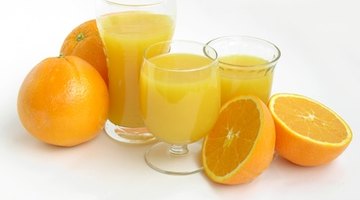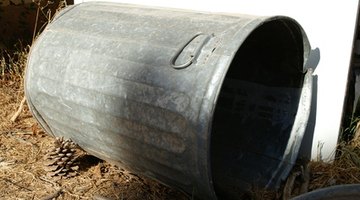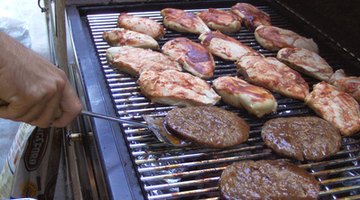Galvanised steel is an iron alloy that’s been immersed in zinc to increase its resistance to corrosion. It’s used in construction of bridges, storage tanks, structural steel, duct work, fasteners, light poles, pipes, sign supports, reinforcing steel and wire and auto manufacturing. It is not a popular cookware material but it is found in bread cooling racks, pallet racks in freezers and makes a strong, durable coating for counter tops in restaurants. Top quality cookware and knives are manufactured from stainless steel. This is a metal alloy of iron and contains varying proportions of chromium, nickel, carbon or other metals. Follow the same precautions for the safe use of stainless steel cookware as with galvanised utensils.
Hazards From Acidic Foods

Zinc coatings on galvanised steel do not hold up well when placed in contact with acidic foods and beverages. The zinc is converted to zinc salts which are readily absorbed by the human body. Excessive levels of these salts can cause headaches, nausea and malaise.
Foods containing citric acid such as oranges, lemons, grapefruit juice should not be in prolonged contact with galvanised steel. Foods containing lactic acid (milk and dairy products), breads, cakes, custard, buttermilk and fermented beverages should come into contact with galvanised steel cooking utensils. They should also not be stored in containers made of galvanised steel. Acetic acid in vinegar, pickles and relish can also cause corrosion in galvanised steel.
- Zinc coatings on galvanised steel do not hold up well when placed in contact with acidic foods and beverages.
- Acetic acid in vinegar, pickles and relish can also cause corrosion in galvanised steel.
Hazards of Food Preservatives

Smoked and cured meats contain high quantities of nitrites which should not come into contact with galvanised steel as they can cause corrosion and formation of zinc salts. These products also contain high concentrations of salt, which can react with the zinc coating on galvanised steel. Grapes that have been treated with preservatives, such as sulphur dioxide, for longer shelf life, should not be exposed to galvanised steel.
Galvanised Steel and Smoked Meat

The United States Department of Agriculture (USDA) advises consumers to smoke meat and poultry in smokers made of approved materials. Galvanised steel cans and other makeshift smokers should not be used. Chemical residue created by prolonged heating of the galvanised container is deposited on meat surfaces, which can contain toxic zinc salts.
Food Hazards From Galvanized Steel Barbeques - Grills

When galvanised steel reaches a high temperature after heating, it gives off smelly, toxic fumes of zinc oxide. Therefore, a galvanised steel grill, stove or barbecue should only be used outdoors. There is a risk of a developing “metal fume fever” from breathing these fumes. Symptoms include loss of appetite, muscle stiffness and pain, fever, diarrhoea and headache. These symptoms are vague and often mistaken for an onset of flu. Since illness usually develops several hours after exposure, it is difficult to make the connection between it and the stove or barbecue. The symptoms usually resolve within 48 hours. Toxic fumes may deposit chemical contaminants on the surfaces of barbecued food. Because there's a reaction between blood and galvanised steel, raw meat should not be placed directly on its surface. Galvanised steel barbecues, stoves, pot stands or grills should be kept at high heat until all unpleasant fumes are dissipated before it's used.
- When galvanised steel reaches a high temperature after heating, it gives off smelly, toxic fumes of zinc oxide.
- Since illness usually develops several hours after exposure, it is difficult to make the connection between it and the stove or barbecue.
..
